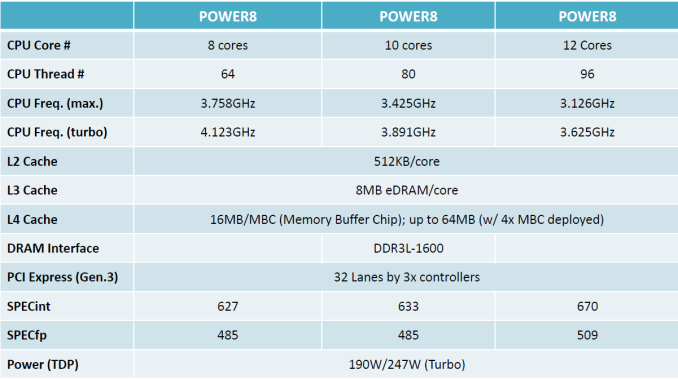The Intel Xeon E7-8800 v3 Review: The POWER8 Killer?
by Johan De Gelas on May 8, 2015 8:00 AM EST- Posted in
- CPUs
- IT Computing
- Intel
- Xeon
- Haswell
- Enterprise
- server
- Enterprise CPUs
- POWER
- POWER8
The Competitor: IBM's POWER8
As we briefly mentioned in the introduction, among all of the potential competitors for the Xeon E7 line, IBM's OpenPower might be the most potent competitor at this time. So how do IBM's offerings compare to Intel's? IBM POWER 8 is a Brainiac (high IPC) design that also wants to be speed demon (high clock speeds).
The POWER8 core can decode, issue and execute and retire 8 instructions per cycle. That degree of of instruction level parallelism (ILP) can not be extracted out of (most) software. To battle the lack of ILP in software, no less than 8 threads (SMT) are active per core. According to IBM,
- 2-threads delivers about 45% performance more than one
- 4-threads deliver yet another 30% boost
- the last 4-threads deliver about 7%
So in total, the 8-way SMT doubles the performance of this massive core. Let us compare the two chips.
| Xeon E7v3/POWER8 Comparison | ||
| Feature | Intel Haswell-EX Xeon E7 |
IBM POWER8 |
| Process tech. | 22nm FinFET | 22nm SOI |
| Max clock | 2.5-3.6 GHz | 3.5-4.35 GHz |
| Max. core count Max. thread count |
18@2.5 GHz 36 SMT |
12@4.2 GHz 96 SMT |
| Max. sustained IPC | 6 (4) | 8 |
| L1-I / L1-D Cache | 32 KB/32 KB | 32 KB/64 KB |
| L2 Cache | 256 KB SRAM per core | 512 KB SRAM per core |
| L3 Cache | 2.5 MB SRAM per core | 8 MB eDRAM per core |
| L4 Cache | None | 16 MB eDRAM per MBC (64/128 MB total) |
| Memory | 1.5 TB per socket (64 GB per DIMM) |
1-2 TB per socket (64 GB per DIMM) |
| Theoretical Memory Bandwidth | 102 GB/s (independent mode) |
204 GB/s |
| PCIe 3.0 Lanes | 40 Lanes | 32 Lanes |
The POWER8 looks better than Haswell-EX in almost every spec, but the devil is of course in the details. First of all, Intel's L2-cache works at the same clock as the core, IBM's L2-cache runs at a lower clock (2.2 GHz or less, depending on the model). Secondly, the POWER8's L3 eDRAM cache might be much larger, but it is so also a bit slower.
But the main disadvantage of the POWER8 is that all this superscalar wideness and high clockspeed goodness comes with a power price. This slide from Tyan at the latest OpenPOWER conference tell us more.
A 12 core POWER8 is "limited" to 3.1 GHz if you want to stay below the 190W TDP mark. Clockspeeds higher than 4 GHz are only possible with 8-cores and a 250W TDP. This makes us really curious what kind of power dissipation we may expect from the 4.2 GHz 10-core POWER8 inside the expensive E870 Enterprise systems (300W?).
That is not all. Each "Jordan Creek2" memory buffer on the Intel system is limited to about 9W. IBM uses a similar but more complex "Centaur" memory buffer (including a 16 MB cache) which needs more than twice as much energy (16-20W). There are at least four of them per chip, and a high-end chip can have eight. So in total the Intel CPU plus memory buffers have a 201W TDP (165W CPU + 4x9W Jordan Creek 2), while the IBM platform has at best a 270W TDP (190W CPU+ 4x20W MBC).











146 Comments
View All Comments
TheSocket - Friday, May 8, 2015 - link
They sure wouldn't lose the x86-64 license since they own it and Intel is licensing it from AMD.melgross - Saturday, May 9, 2015 - link
But without the license from Intel, it is worthless. There's also the question of how that works. I believe that Intel doesn't need to license back the 64 bit extensions.Kevin G - Monday, May 11, 2015 - link
This one of the reasons why it would be in Intelsat best interest to let AMD be bought out with the 32 bit license intact. The 64 bit license/patents going to a third party that doesn't want to share would be a dooms day scenario for Intel. Legally it wouldn't affect anything currently on the market but it'd throw Intel's future roadmap into the trash.Death666Angel - Saturday, May 9, 2015 - link
Pretty sure some regulatory bodies would step in if Intel were the only x86 game in town. And x86-64 is AMD property.JumpingJack - Saturday, May 9, 2015 - link
Any patents on x86 are long expired, AMD only owns the IP related to the extension of the x86 not the instruction set.patrickjp93 - Monday, May 11, 2015 - link
Not true. The U.S. government has them locked up under special military-based protections. Absolutely no one can make and sell x86 without Intel's and the DOD's permission.Kevin G - Monday, May 11, 2015 - link
Got a source for that?I know that DoD did some validation on x86 many years ago. (The Pentium core used by Larrabee had the DoD changes incorporated.)
haplo602 - Friday, May 8, 2015 - link
hmm ... where's the RAS feature comparison/test ? did I miss it in the article ?TeXWiller - Friday, May 8, 2015 - link
In the E7v3 vs POWER comparison table, there should be 32 PCIe lanes instead 40 in the Xeon column.TeXWiller - Friday, May 8, 2015 - link
Additionally, it is the L3 in POWER8 that runs half of the core speed. L2 runs at the core speed.